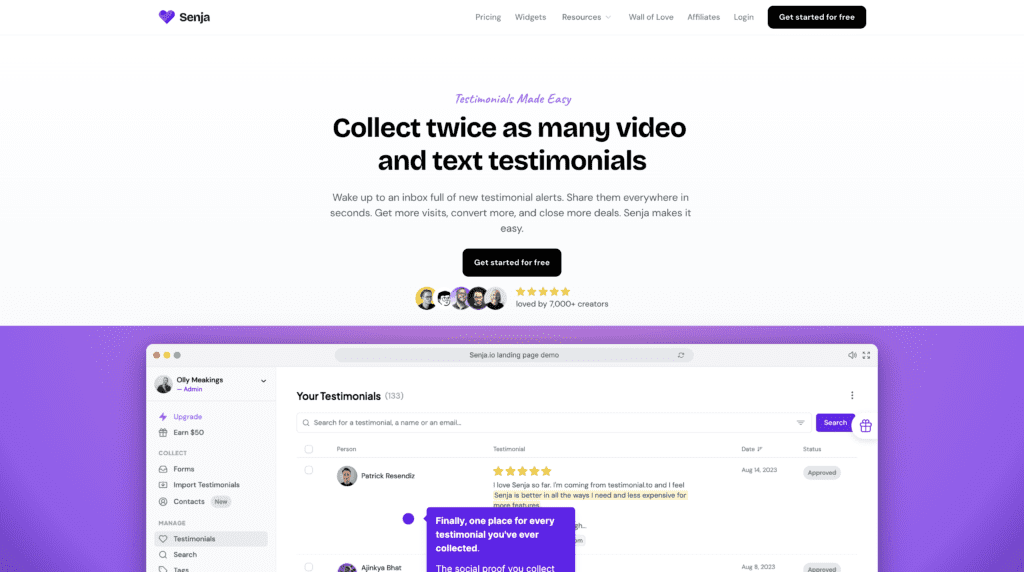The Science of Improving Your Landing Page Conversions
Creating a landing page that’s well-optimized for conversions is hard.
When I created my first SaaS business, I didn’t know where to start with website design. As a software engineer, I’d never really focused on making things look pretty and enticing people to buy a product, so I largely used trial and error to try and make high-converting landing pages.
While I wouldn’t recommend this approach to any entrepreneurs, it did mean that I’ve now got a lot of experience in measuring what works on your current landing page and updating what doesn’t. In this article, I’m going to reveal all my tips so that you can improve the conversion rate on your site.
By the way, if you are currently creating your landing page, read my ultimate guide to creating a high-converting landing page here to learn from the mistakes that I made.
If you’re more of a watcher than a reader, then check out this great video by Josh Hall about his 7 tips for increasing website conversions.
Step 1: Get Data
Collecting the right data from your landing page is crucial so that you can analyze its current performance and identify exactly what needs to be changed.
In my opinion, at a minimum, you need to collect:
- Traffic Sources: Knowing where your visitors come from can help you identify which outbound marketing techniques are working for your business – e.g. social media accounts / Google ads
- Total Visitors: The total number of people who visited your landing page.
- Unique Visitors: The number of distinct individuals who visited your page, eliminating duplicate visits from the same user.
- Bounce Rate: The percentage of potential customers who left your landing page without interacting with it.
- Click-Through Rate (CTR): Identifying the percentage of potential customers who clicked on a specific call-to-action
- Conversion Rate: The percentage of visitors who completed the desired action on your landing page, such as signing up, making a purchase, or downloading a resource.
- Time Spent on Page: The average time a potential customer spent on your landing page.
- User Demographics: This helps you identify if your site is targeting the right demographic of users
There are honestly so many more metrics that I can’t even cover here, but the point is that you need to make sure you’re tracking as much of this data as possible (as long as it’s relevant). You can’t hope to make improvements to your website conversion rates if you don’t know exactly what’s wrong so get going.
If you’re not yet tracking anything on your site, I’d recommend you use either:
- Google Analytics: a free and widely used analytics tool created by Google
- Fathom Analytics: A cheap, privacy-first analytics tool that provides an incredible amount of data about your users
Step 2: Set Clear Objectives
Now that you’ve got some data to analyze, I’d recommend that you set clear goals so you know what you want to improve and whether you’re actually improving things or making the problem worse.
These goals should be SMART, meaning that they’re specific, measurable, achievable, relevant, and time-bound objectives so that they provide a clear and structured way to measure the changes in your conversion rate.
For example, when I was looking to improve the conversion rate of my last business, I set the following goals:
- Increase Sign-ups: Increase the monthly free account sign-ups from 100 to 300 within the next three months.
- Boost Conversions: Increase the number of premium-package SaaS subscriptions from 50 to 100 within the next six months.
- Improve Click-Through Rates: Achieve a 20% increase in the click-through rate from the landing page to product pages within the next two months.
- Enhance User Engagement: Increase the average time spent on the landing page from 1 minute to 2 minutes within the next three months.
- Reduce Bounce Rate: Decrease the bounce rate from 60% to 40% within the next four months.
As you can see, these goals are incredibly specific, giving me data-driven targets and timeframes to help me improve the site. The difficulty now though is working out exactly how to improve the landing page conversion rate. And to do this, I’d recommend starting with your competitors.
Step 3: Analyze Your Competitors
Analyzing your competitors’ websites is probably the easiest way to understand exactly what you need to change to optimize your site’s conversion rate. If people are signing up with your competitors, then there’s probably at least something you can learn to help capture your target audience’s attention.
When studying my competitor’s landing pages, I often look out for:
- Design and User Experience:
- Assess the overall design and layout of your competitor’s website. What’s the design style and which components have they put on their site?
- Look for easy navigation, clear call-to-action buttons, and a logical flow from landing page to conversion.
- Content Quality:
- Analyze the quality and relevance of the content on your competitor’s site. What information do they provide and how do they capture the attention of their potential customers?
- Pay attention to the use of images, videos, infographics, and other multimedia elements.
- Messaging and Value Proposition:
- Examine how your competitors communicate their unique value proposition. Are they clear about the benefits of their product and which features do they emphasise?
- Look for persuasive copy and headlines that address their target market’s pain points.
- Social Proof:
- Determine which types of testimonials your competitors feature on their website – customer reviews, testimonials, case studies, or trust symbols on their websites.
- Pricing and Offers:
- Investigate the pricing strategies and offers presented by your competitors. Are they transparent about costs and incentives?
- You can learn more about setting great pricing strategies for your products here if you’d like to learn more.
- SEO Strategies:
- Are there certain keywords, phrases or blog posts that your competitors are targeting to get more traffic from search engines?
- Click here to learn more about how you can optimize your landing page for search engines.
While it’s important that you don’t copy exactly what your competitors are doing, analyzing their sites can give a lot of inspiration about certain tactics or site components that you should be targeting to either get more potential customers on your site or improve your site’s conversions.
Step 4: Analyze Your Funnels
Now that you’ve looked externally at your competitor’s landing pages, it’s time to look at your own.
I’d recommend taking a good look at your own sales funnel to make sure that your potential customer’s user journey is as smooth as possible when learning about your product and proceeding to make a purchase. It’s important to walk through the user journey step-by-step to help you identify where potential pain points could be that could confuse users or make them not want to buy your product.
For example, when running through the user journey on my last startup, I found that I had multiple broken links on my landing page and some outdated copy. While these may sound like insignificant issues, I’ve found that even small things can be enough to put off customers from buying a product.
If you don’t believe me, then you just need to look at the data. One study shows that approximately 69% of shoppers abandon their carts on the average e-commerce site, so even slight improvements can massively improve your conversion rates.
Step 5: Improve Your Page Design
It’s also important to improve the design and content of the pages on your website themselves. Below, I’ve included my 7 tips for creating an incredibly high-converting page.
The Power of a Persuasive Headline
The first step is to state your value proposition boldly and clearly in the header. Your headline is your golden ticket to capturing your audience’s attention. Remember, humans have shorter attention spans than goldfish!
Your headline should be concise, bold, and straight to the point, ideally within seven to eight words.
Visual Appeal
Visual content is your second ace. Whether it’s a striking image, a product shot, or a compelling video, having a visual focus is crucial to keep visitors engaged and moving forward.
Benefits > Features
While it’s essential to outline the features of your product, the emphasis should be on the benefits it has for the customer.
Remember, people buy solutions to their problems, not features. Speak directly to your audience’s pain points, and highlight how your product or service resolves them.
The Power of a Single Call To Action (CTA)
Keep it simple. Focus on one primary call to action.
Don’t inundate your page with multiple CTAs. After you’ve presented all the necessary information, that’s the perfect time for your primary CTA.
Include Testimonials
Reviews and testimonials provide invaluable insight and build trust. People want to know how others have experienced your product or service. Include genuine feedback to help potential customers make informed decisions.
Offer a Guarantee
A money-back guarantee or a risk-free trial demonstrates your confidence in your product. It lowers the perceived risk for your customers and can help boost conversions.
Tell a Story
The power of storytelling should never be underestimated. We all love a good story, and integrating storytelling into your landing page can take your audience on an emotional rollercoaster, making them more likely to convert.
Step 6: Improve Your Sales Copy
As we’ve just been talking about telling a story to your users, let’s delve more into creating great copy to convert your users.
As I used to be a software engineer, I found writing high-converting copy really difficult. I didn’t really have to deal with professional writing in my day job, so I never used to know exactly what to say and how to say it. Over the years, I’ve gotten much better, and that’s largely been down to me following these 6 tips for writing great copy:
- A Free High-Value Promise: Begin your copy by creating a compelling promise of high value. Give your visitors something you’d want to receive.
- A Strong Reason Why: Address your visitors’ inner critic. Explain why you’re what you’re offering appeals to them and why they should take action right now.
- Authentic Social Proof: People rely on social cues from others to inform their decisions. Showcase how others have benefited from your product, service, or content. Use user testimonials, social media comments, or positive reviews to build trust and authority.
- Trust Factors: Ensure your landing page conveys trustworthiness. Address concerns about privacy and other potential issues with your product.
- A Crystal Clear Call to Action: Make your call to action (CTA) unambiguous and easy to find. Your CTA should leave no room for confusion on what action your visitors should take. Consider breaking multi-step processes into smaller commitments to increase conversions.
- Brand Consistency: Maintain consistency in your brand’s voice and messaging across all marketing channels, campaigns, and customer touchpoints. This congruence builds trust and keeps your audience engaged.
If you’re looking for more inspiration, check out the copy on Senja’s landing page here.

Step 7: Optimize Page Speed
Optimizing page speed on your landing page is crucial for a variety of reasons, including user experience, SEO, and conversion rates.
Slow-loading pages can deter visitors, increase bounce rates, and ultimately lead to a negative impact on your business. In fact, a study by Google found that 53% of mobile site visitors leave a page that takes longer than three seconds to load.
With that in mind, let’s explore how to improve the page speed of your landing page.
How to Optimize The Page Speed Of Your Landing Page
- Compress Images: Use image compression tools to reduce image file sizes without compromising quality. Tools like TinyPNG or ImageOptim can help.
- Minimize HTTP Requests: Reduce the number of HTTP requests by combining CSS and JavaScript files, and use CSS sprites to combine multiple images into one.
- Leverage Browser Caching: Set up browser caching to store resources locally in a visitor’s browser, reducing server requests for returning users.
- Content Delivery Network (CDN): Use a CDN to distribute content across multiple servers geographically. This reduces server response time and speeds up page loading.
- Minimize Redirects: Reduce the number of redirects on your page. Each redirect adds time to the page load.
- Optimize Code: Clean and minimize your HTML, CSS, and JavaScript code. Remove unnecessary whitespace and comments.
- Server Performance: Invest in a reliable hosting provider with good server performance. Server response time impacts page speed.
- Reduce Third-Party Scripts: Limit the use of third-party scripts and widgets on your page, as they can slow down loading times.
- Lazy Loading: Implement lazy loading for images and videos so that they only load when they come into the user’s viewport.
- Mobile Optimization: Ensure your landing page is mobile-responsive, and consider using Accelerated Mobile Pages (AMP) to speed up loading times on mobile devices.
While this may seem quite technical, these under-the-hood changes can massively improve your user’s experience and may even improve your performance in search engines, which will give you even more potential leads.
Step 8: Improve Navigation
Improving navigation on your website is crucial for enhancing user experience and increasing the conversion rate of your business’ website.
Intuitive navigation options allow your visitors to find the information they need when exploring what your products can do for them.
To help you make sure that your website navigation is in check, here’s my 2 tips for improving your menu structures:
- Simplify
- Eliminate unnecessary menu items and consolidate similar ones. You want users to be able to quickly find exactly what they’re looking for
- Place essential pages (e.g. product features, contact information, and conversion-focused pages) prominently in the main menu
- Implement Clear Calls to Action (CTAs)
- Ensure your menu labels are clear and descriptive, so users understand where each link will take them
- Make sure that your primary CTAs are prominent in the navigation – e.g. having “Sign Up” links in a different colour
You probably won’t get this 100% right on your first attempt. As simple as it seems, I’ve found that navigation options are something that needs constant tweaking to make sure that you’re converting the most users. Make sure to keep checking the analytics tools that you set up in Step 1 to keep on top of this.

Step 9: Re-Analyze and Iterate
Now that you’ve implemented all of these things, it’s time to look back at the goals that you set in Step 2 and see whether things have changed in the right direction or not.
Improving your website’s conversion rate isn’t something that you can just do once and forget about. There are always new things to optimize, your customers are always changing, and your product’s always changing too.
I’d recommend auditing your website’s performance every quarter at a minimum to see if there are any further improvements to make to help increase your conversions even more.
Download Our Free Landing Page Boosting Checklist
If you’d like to download our checklist to help you improve your conversions, click the button below.
Key Takeaways
- Collect Data: Start by gathering relevant data from your landing page, including traffic sources, visitor metrics, bounce rate, click-through rate, and conversion rate. This data is essential for understanding your current performance.
- Set Clear Objectives: Establish SMART goals that are Specific, Measurable, Achievable, Relevant, and Time-bound. These goals will help you track your progress and focus on what needs improvement.
- Analyze Competitors: Study your competitors’ landing pages to identify effective design elements, content quality, messaging, social proof, pricing strategies, and SEO tactics. While not copying them, draw inspiration from what works for them.
- Analyze Your Funnels: Review your sales funnel to ensure a smooth user journey. Identify potential pain points and issues that may deter users from making a purchase or taking the desired action.
- Improve Page Design: Optimize your landing page’s design with a persuasive headline, visual appeal, emphasis on benefits over features, a clear call to action (CTA), testimonials, and a money-back guarantee. Maintain brand consistency.
- Improve Sales Copy: Write compelling and persuasive copy by focusing on a high-value promise, a strong reason why, authentic social proof, trust factors, a crystal-clear CTA, and brand consistency.
- Optimize Page Speed: Improve page loading speed by compressing images, minimizing HTTP requests, leveraging browser caching, using a Content Delivery Network (CDN), and optimizing code. Ensure mobile optimization.
- Improve Navigation: Simplify your menu structure by eliminating unnecessary items and placing essential pages prominently. Implement clear and descriptive CTAs in your menu.
- Re-Analyze and Iterate: Continuously assess your landing page’s performance and re-evaluate your goals. Regularly analyze data and make adjustments to further enhance conversion rates.
Overview
Now that you’ve improved your landing page, check out our complete guide to identify the KPIs (Key Performance Indicators) for your business. If you’re looking to improve other areas of your sales pipeline, check out our ultimate guide here.
Alternatively, have a look at our guide to getting your first 1,000 customers.







